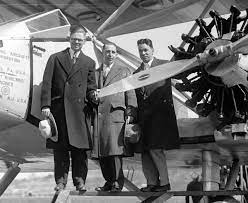On August 24, 1927, a significant event took place in the United States that marked a major milestone in aviation history. On this day, a team of aviators successfully completed a transcontinental flight across the United States, setting a new record and showcasing the growing potential of air travel. The flight, known as the Dole Air Race, was organized to commemorate the 50th anniversary of the United States' acquisition of Alaska from Russia. The race was named after James Dole, a pineapple magnate who sponsored the event and offered a substantial cash prize for the first aviator or team to successfully fly from Oakland, California, to Honolulu, Hawaii. Six airplanes and their crews participated in the Dole Air Race, each aiming to be the first to complete the challenging journey over the Pacific Ocean. The route was approximately 2,400 miles long, and the aviators faced numerous hazards, including treacherous weather conditions, limited navigation aids, and the need to carry sufficient fuel for the long flight. The team that ultimately emerged victorious in the Dole Air Race was the duo of Ernie Smith and Emory Bronte. They piloted a Travel Air monoplane named the "City of Oakland" and completed the journey to Honolulu in just over 26 hours, setting a new record for a transpacific flight. The successful completion of the Dole Air Race was a significant achievement in aviation. It demonstrated the increasing capabilities of airplanes and the potential for long-distance air travel. The race captured the public's imagination and highlighted the bravery and skill of the aviators who were pushing the boundaries of what was thought possible in aviation at the time. The Dole Air Race also had broader implications for the development of commercial aviation. The event drew attention to the potential economic and social benefits of air travel, particularly for long-distance journeys. It sparked public interest in aviation and helped pave the way for the growth of commercial airlines, which would play a crucial role in connecting people and places across the globe. Furthermore, the Dole Air Race highlighted the importance of technological advancements in aviation. The participating aviators relied on the latest navigation instruments and radio communication systems to navigate the challenging route. The race spurred further innovation in aircraft design, engine efficiency, and navigation aids, ultimately contributing to the advancement of aviation technology. The successful completion of the Dole Air Race was a testament to the courage, skill, and determination of the aviators involved. It showcased the spirit of adventure and exploration that defined the early years of aviation. The race inspired generations of aviators and contributed to the ongoing progress and achievements in the field of aviation.
24 Aug, 1927 U.S.A. Airplane Aviators
